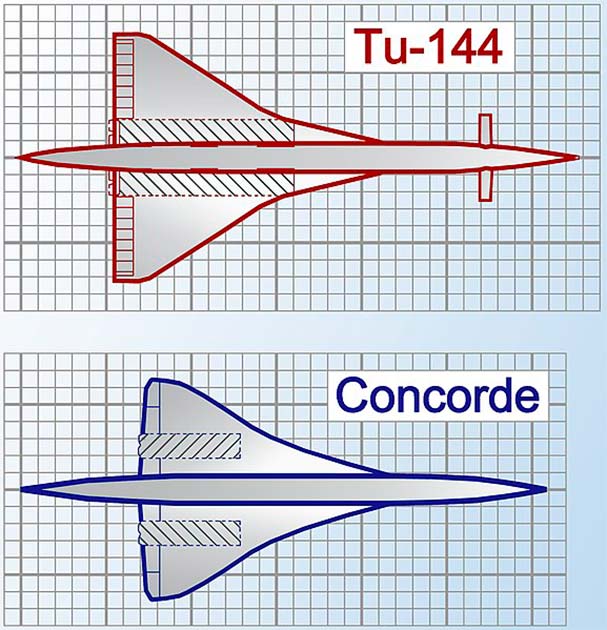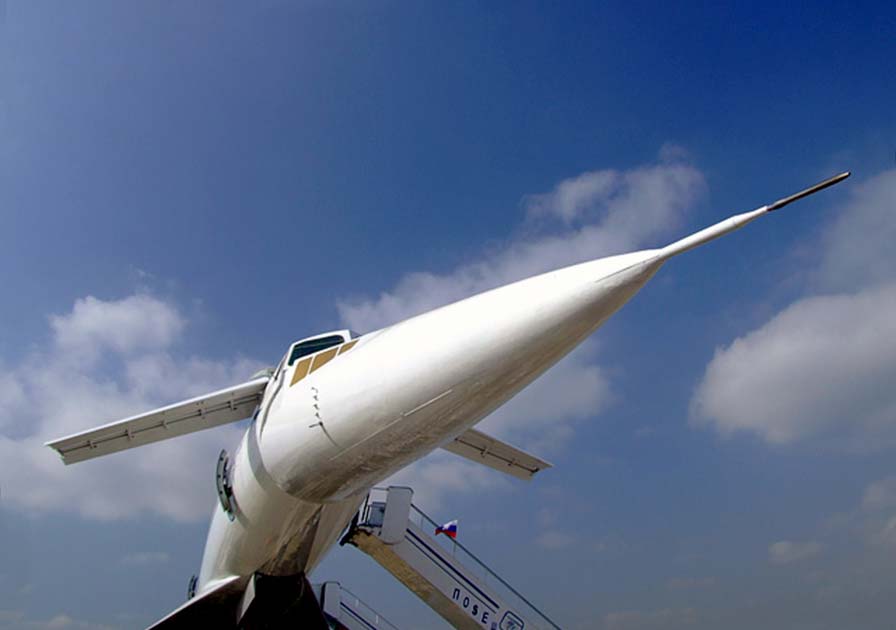The ability to fly at supersonic speeds or faster than the speed of sound (known as Mach 1, around 767mph or 1,234 kmh) is something many militaries have prioritized for their fighter jets. Only specialists who are highly trained pilots are permitted to fly supersonic aircraft, and the top scientists, engineers, and experts in fluid mechanics and aerodynamics have spent decades developing these high-powered aircraft.
But what if you could buy a ticket to travel at supersonic speed to a destination of your choice? While that sounds like something from the Jetsons, during the Cold War, people could do just that.
The Franco-British Concorde was the most well-known supersonic passenger airliner, which stayed in service until 2003. Many people don’t know that the Soviet Union and its “Concordski” beat the West to it, and were the first to build, fly, and use a supersonic passenger plane.
The Concordski
The “Concordski” was the nickname the West gave to the Tupolev Tu-144 Soviet supersonic passenger airliner. It got the name “Concordski” because its design was (suspiciously) similar to the British–French Concorde version of a supersonic aircraft.

Most of history remembers the Concorde, but the Tu-144 came first. The first flight of the Tu-144 took place on December 31, 1968, a full two months before the Concorde took its maiden flight.
Not only did the “Concordski” Tu-144 fly first, but it also was the first aircraft to travel at supersonic speed, four months before the Concord did. The Tu-144 was the first commercial aircraft to travel faster than Mach 2 (1,534.54 miles per hour). While the “Concordski” achieved many things, significant issues with the aircraft led to its discontinuation as a passenger airliner.
But where did it come from? During the Cold War, the Soviet Union always tried to outshine the West. Doing it bigger and faster than the West was tantamount to success. The same was true when it came to the “Concordski.”
- The T-104 Pushkin Crash: Soviet Admirals and the Dangers of Pulling Rank
- The Hughes H-4 Hercules: was the Spruce Goose ever Going to Work?
Both the Concorde and the Tu-144 were far beyond their time when one considers that civil aviation had just shifted from prop planes to jets. The two aircraft looked very similar, hence the nickname “Concordski,” and there were a lot of allegations of Soviet espionage.
While espionage might well have been possible, and there were incidents where both the US and the USSR copied and researched tech from military vehicles designed by the other. But Dr. Ilya Grinberg, the top Soviet aviation expert, said about the two aircraft, “Although they look alike, they are rather different planes with many different aspects. External similarities are based on functional criteria and required parameters.”
For a start, the “Concordski” was much larger and faster than the Concorde. It had a pair of winglets known as canards located just behind the cockpit. These canards were able to provide extra lift as well as control at low speeds.
This is not to say the Tu-144 was the better design. The source of many of the Tu-144’s issues was that it, like other Soviet projects, was designed and made operational in a very rushed process. The designers didn’t take the time to refine some of the aspects of the aircraft that would have made the aircraft safer for commercial and passenger flights.
One issue that impacted the success of the “Concordski” was that the technology developed by the West was simply better, with longer and more careful design processes leading to more sophisticated solutions. This was made particularly apparent when the USSR requested details on a lot of technologies from the Concorde in 1978 to improve their own aircraft, which shed light on some of the many issues the Tu-144 had.
The USSR asked for drain valves for fuel tanks, firefighting equipment, piloting and navigation controls, fireproof paints, and more. The British government however voted not to provide information about these technologies to the Soviet Union because the technology could also be added to Soviet bombers.
Equipment failures from imperfect production processes were also typical for the Tu-144. A compressor disk failed in 1980, which forced an emergency landing due to damage to the structure of the aircraft and its operating systems.
But none of this stopped the Tu-144 being used as a passenger plane, approximately 55 times, although the number of failures that occurred on these flights was in the hundreds. Considering the flight route was only two hours long from Moscow to Almaty (then known as Alma Ata), Kazakhstan, the amount of failures that happened should have been more than enough to keep these planes grounded.

Some issues on the Concordski include toilets that didn’t work, alarms going off the cabin depressurizing, engine failure, and one of the most significant issues for passengers was how loud the aircraft was.
The engines needed to keep their afterburners on while traveling at supersonic speeds, along with the noise from the air conditioning system in the cabin. The sound was so deafening that passengers had to pass handwritten notes to each other just to talk.
1973 Paris Air Show
On June 3, 1973, the Concorde and the “Concordski” met in Paris for the Paris Air Show. Both aircraft were going to perform demonstrations for the audience. The Concorde performed first without any issues; then, it was time for the Tu-144.
- Project Azorian: Did Howard Hughes Try to Steal a Russian Sub?
- Joe-1: The Story of the First Soviet Nuclear Bomb
The pilot of the Concordski wanted to show off by forcing the plane into more challenging aerobatics than Concorde had just performed, and took the plane into a very sharp incline before it took a steep dive. The audience watched in horror as the left wing was torn from the aircraft, followed shortly by the tail.
Fuel was pouring out, which triggered an explosion that further disintegrated the frame of the Tu-144. The Concordski crashed into the village of Goussainville and leveled 15 houses. All six people in the Tu-144 were killed, as well as eight villagers (including three children). Over sixty people were injured by the falling wreckage of the Concordski.
Some of the French spectators believed the crash was caused by the pilot making a dive in order to restart failed engines. The Soviets however had another theory, saying that the crash was caused because the Tu-144 had tried to avoid a French Mirage plane that was “attempting to photograph its [Tu-144] canards.”

The other half of the theory is that the Soviet Union and France both agreed this was what had happened, but colluded with each other to hide this information. In the original French reports, the claim of a Mirage involved was denied.
Was that claim dismissed because the French were engaging in industrial espionage? According to recent reports, it seems there was indeed a Mirage in the area at the time, and the Soviet crew was not informed about the Mirage flying at that time, but it didn’t cause the crash.
Was the Mirage the culprit, or was it yet another example of the Soviet Union taking too many risks in attempting to go above and beyond what the West had done? Either way, the Paris air crash was the death knell for Soviet supersonic civilian travel.
Top Image: The Tupolev Tu-144, nicknamed Concordski by the West. Source: RIA Novosti archive, image #566221 / Lev Polikashin / CC BY-SA 3.0.